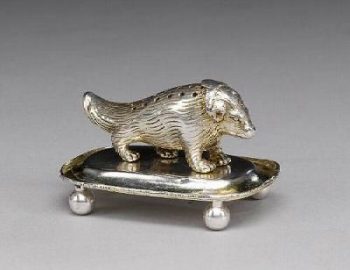|
TOOTHPICK HOLDER (FIGURAL)
Anthropologists believe that early men picked their teeth with sticks
cut to a sharp point.
Evidence of Stone Age toothpicks is indirect but compelling and the
demonstration is on fossil teeth. Analysis of their marks has led to the
consensus that they were made by heavy toothpick use by our early
ancestors.
The grooves were especially common in the teeth of Neanderthals who
lived in Europe and Asia, about 100,000 years ago. Similar markings have
been found in the fossilized teeth of both American Indians and
Australian Aborigines.
At this age people did not know how to repair teeth and only good care
was the method to maintain their teeth, so they tried clean their teeth
instinctively and a branch of wood was the beginning of toothpick.
Toothpicks were introduced into Japan about 528 along with Buddhism via
China and Korea. In India twigs from Neem tree were used but as they did
not grow in China use was made of the willow tree, a spicebush, a cedar,
a peach tree, or a bamboo.
The clean custom of the toothpick migrated from the usual life of
Buddhist monks very shortly to the nobles. Soon officers of the Court
and Shinto priests began to imitate their clean custom. |

Romans and Greeks were also avid oral hygiene enthusiasts.
The early Romans had their own dental-care preferences. Pliny the
Younger of Rome (61-113 A.D.) proclaimed that using a vulture quill as a
toothpick would cause halitosis, but using a porcupine quill was
acceptable because it 'made the teeth firm'.
In fifteenth-century Europe, picking the teeth was widely accepted until
philosophers began to issue conduct warnings. Rhodes said: 'Pick not thy
teeth with thy knyfe, but take a stick, or some clean thyng, then doe
you not offend'.
Personal silver, gold or ivory toothpicks were widely used in the Middle
Age and often were included in travelling sets together with knife and
spoon.
At the beginning of 19th century, with the introduction of disposable
wooden toothpicks, the use of figural holders suitable to display the
toothpicks on the table, spread in Continental Europe.
Usually these holders had a pierced base or a small container where
sunburst toothpicks ornamentations were inserted.
|

www.silvercollection.it |
This is a page of 'The What is? Silver Dictionary' of A Small Collection of
Antique Silver and Objects of vertu, a 1500 pages richly illustrated website offering all you need to know about
antique silver, sterling silver, silverplate, Sheffield plate, electroplate silver,
silverware, flatware, tea services and tea complements, marks and hallmarks, articles,
books, auction catalogs, famous silversmiths (Tiffany, Gorham, Jensen, Elkington),
history, oddities ...
HOME - SITE MAP - SILVER DICTIONARY - COOKIES CONSENT AND PRIVACY |
| |